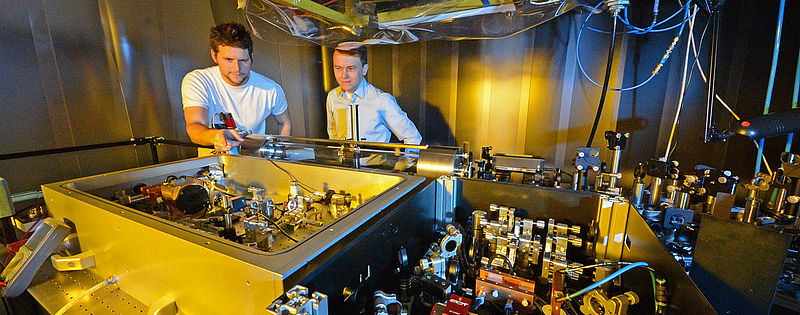featured publications – Scientists often need to detect and measure levels of specific substances in a sea of irrelevant molecules, and infrared light offers an ideal tool for this task. Infrared radiation is invisible to the human eye, but molecules react with mid-infrared light in ways that are extremely sensitive to their precise atomic structure. This provides a means of identifying with great specificity molecular solutes present in very low concentrations. Lasers that generate light in the mid-infrared range suitable for use in molecular sensors are therefore the subject of intensive research. Now teams from the Ludwig-Maximilians-Universität (LMU) and the Laboratory for Attosecond Physics at the Max Planck Institute of Quantum Optics (MPQ), in collaboration with the Institute of Photonic Sciences (ICFO) in Barcelona, have developed a unique source of coherent radiation for this purpose.
With the aid of the rapid trains of bright, ultrashort light pulses produced by the new laser, it should soon be possible to detect vanishingly small amounts of specific molecular species against the background of billions of others. The scientists intend to utilize their high-performance instrument as the basis for a non-invasive diagnostic technique that can detect disease markers in exhaled breath. Their latest findings appear in the journal »Nature Photonics«.
Unique source of ultrashort pulses
The fact that the light we perceive does not represent the full spectrum of radiation emitted by the sun was first recognized at the beginning of the 19th century by the German-born British astronomer William Herschel. By analyzing sunlight with a prism and an array of thermometers, he detected a rise in the ambient temperature beyond the red end of the visible spectrum: Herschel had discovered infrared light. Today, infrared radiation is not only used to probe the nature of stars, it can also tell us about processes in the microcosmos. Together with their colleagues at the Institute of Photonic Sciences (ICFO) in Barcelona, the Munich researchers have constructed a laser system that provides a bright source of mid-infrared light and precise control over its quality and properties.
With this new laser, the scientists have created a uniquely powerful source of infrared radiation that permits them to exploit several useful characteristics of laser light at once. First, the radiation produced is extremely bright: Each and every short pulse consists of enormous numbers of photons of the same wavelength. Secondly, the optical bandwidth covers virtually the entire mid-infrared region, extending from 6.8 to 18 μm in wavelength. The light is both spatially and temporally coherent, i.e. it is emitted in well-defined packets of precisely phased waves at regular intervals. Each laser pulse lasts for about 66 femtoseconds (1 fs =10-15 s), which is equivalent to just two oscillations of the optical field. Not only that, the laser emits a train of 100 million such pulses every second.
These capabilities turn the new laser into a searchlight that can detect and identify minimal amounts of molecules dissolved in liquids or in gases. For when infrared radiation interacts with a given molecular species, the wavelengths of the light it absorbs depend on its atomic structure. Thus the set of infrared wavelengths absorbed by a given type of molecule serves as a unique fingerprint for that particular substance. – And this »absorption spectrum« can be measured because the absorbed photons are missing from the radiation that emerges from such an interaction between light and matter. In this way, the transmitted light enables one to deduce the structures of the molecules with which the light interacted on its passage, and so to identify the solutes and their concentrations in the sample. »Since we now possess a compact source of high-intensity and coherent infrared light, we have a tool that can serve as an extremely sensitive sensor for the detection of molecules, and is suitable for serial production,« says Dr. Ioachim Pupeza, scientist at the LMU and head of this project.
Finding needles in haystacks
The infrared laser was designed with one particular application in mind – the early diagnosis of potentially lethal diseases. The idea is to use the infrared pulses to identify and quantify disease markers present in exhaled air. Many diseases, including some types of cancer, are thought to produce specific molecules that end up in the air we expel from our lungs. »We assume that respired air contains well over 1000 different molecular species,« says Dr. Alexander Apolonskiy, scientists of the LMU team. Moreover, the concentrations of molecular biomarkers present in respired air are extraordinarily low. The scientists estimate that they will need an instrument capable of detecting a specific substance present at levels of 1 part per billion in exhaled air. »Thanks to the coherence of the light generated by the new laser, we should be able to detect specific molecules present in such minuscule concentrations in complex mixtures,« says Ioachim Pupeza. The other crucial feature is the extremely broad spectral coverage afforded by this high-intensity source of infrared radiation. »It is this property that makes it possible to distinguish between different molecular fingerprints and so to detect markers diagnostic for precursors of cancer,« says Professor Jens Biegert, who is investigating novel infrared sources and their applications at the ICFO in Barcelona.
The new laser itself is still under development. The next step will be to couple the sub-two-cycle laser with a novel amplifier system. The primary goal is to further increase the number of photons in each pulse, i.e. to enhance the brightness of the light delivered to the target. »In this way, we can enhance the sensitivity of the system by a factor of 1000,« says Pupeza. That would make it possible to detect one target molecule in a sample containing a trillion irrelevant species.
